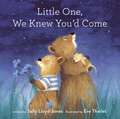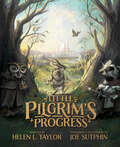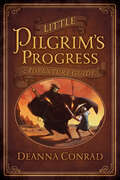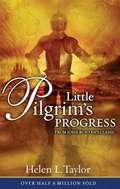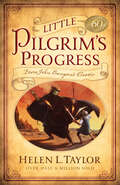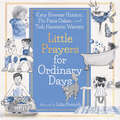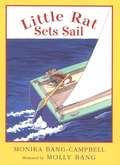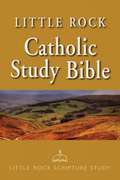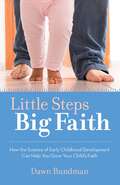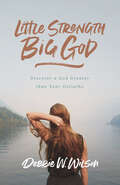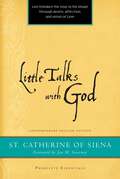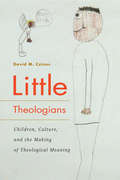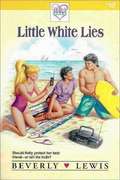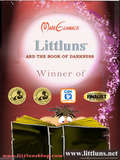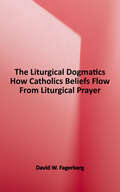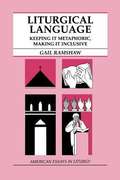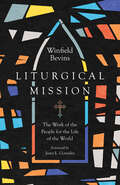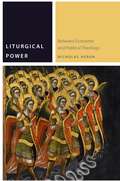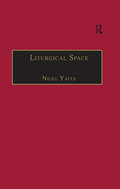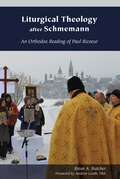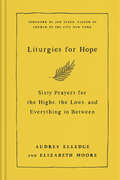- Table View
- List View
Little One, We Knew You'd Come
by Sally Lloyd-JonesFeel the heartwarming joy and anticipation in welcoming a new baby in New York Times bestselling children&’s book author Sally Lloyd-Jones, Little One, We Knew You&’d Come. This endearing story about parent&’s hope and anticipation of a new baby is full of lyrical prose and cute animal illustrations.Overflowing with joy, Little One, We Knew You&’d Come features Sally Lloyd-Jones beautiful rhyming text that shows a parent&’s love and anticipation for their new child. Little one, we knew you&’d come.We hoped. We dreamed. We watched for you.We counted the days till you were due.We waited. How we longed for you,And the day that you were born.Little One, We Knew You&’d Come:Has engaging illustrations and delightful, lyrical textIs a beautiful message for parents and grandparents to read aloud to their children again and againIs a joyful story that celebrates new life and the love we have for our little ones even before their arrivalMakes the perfect gift for a baby shower, new baby, baptism, adoption, new beginning, or special occasion Other books you might enjoy from bestselling author Sally Lloyd-Jones:The Jesus Storybook BibleThe Jesus Storybook Bible Christmas CollectionSong of the StarsBunny&’s First Spring
Little Pilgrim's Progress (Illustrated Edition): From John Bunyan's Classic
by Helen L. TaylorA classic work of literature, adapted for children and beautifully illustrated.Perceiving the need for a simpler version of a timeless classic, Helen Taylor faithfully adapted John Bunyan&’s allegory of the Christian life, The Pilgrim&’s Progress, for young readers—hoping to bring its treasury of wisdom nearer to children&’s hearts and minds. That version has sold over 800,000 copies! It preserves the original plotlines of Bunyan&’s classic while telling the story of Little Christian and Christiana in a way that kids can understand.In this fresh, imaginative new edition, bestselling illustrator Joe Sutphin portrays the characters of Bunyan&’s tale as animals living in a woodland realm. Children will delight in the lavish illustrations, reading alongside their parents or interacting on their own with the timeless words and beautiful imagery that they discover on every page.This book will help children see the trials and triumphs of faithfulness with fresh eyes, leading them to declare along with Christian, &“I am going to the King!&”
Little Pilgrim's Progress (Illustrated Edition): From John Bunyan's Classic
by Helen L. TaylorA classic work of literature, adapted for children and beautifully illustrated.Perceiving the need for a simpler version of a timeless classic, Helen Taylor faithfully adapted John Bunyan&’s allegory of the Christian life, The Pilgrim&’s Progress, for young readers—hoping to bring its treasury of wisdom nearer to children&’s hearts and minds. That version has sold over 800,000 copies! It preserves the original plotlines of Bunyan&’s classic while telling the story of Little Christian and Christiana in a way that kids can understand.In this fresh, imaginative new edition, bestselling illustrator Joe Sutphin portrays the characters of Bunyan&’s tale as animals living in a woodland realm. Children will delight in the lavish illustrations, reading alongside their parents or interacting on their own with the timeless words and beautiful imagery that they discover on every page.This book will help children see the trials and triumphs of faithfulness with fresh eyes, leading them to declare along with Christian, &“I am going to the King!&”
Little Pilgrim's Progress Adventure Guide
by Deanna ConradThe Adventure Guide is designed to help parents, teachers, and students discover and analyze biblical themes and literature concepts while reading Little Pilgrim's Progress. Partnering with the Adventure Guide will make reading this incredible allegory an unforgettable event for your child or student. The guide breaks the novel down into 2 parts, Christian's journey and Christiana's journey. Each journey is separated into four reading sections. These reading sections include vocabulary, questions, allegorical interpretations, literature elements, Bible application, character charts, and character matching. A Parent/Teacher Helps section is also included, offering detailed suggestions regarding story charts, a mapping bulletin board that can also be used as a game, and several art and literature extensions.Oftentimes literature activities become busy work that detracts from the story. But the Adventure Guide activities and story extensions are meaningful and encourage further examination of story characters, themes, and symbolism. A brief biography of John Bunyan is also included to aide in discussion about the original classic, Pilgrim's Progress.
Little Pilgrim's Progress Adventure Guide
by Deanna ConradThe Adventure Guide is designed to help parents, teachers, and students discover and analyze biblical themes and literature concepts while reading Little Pilgrim's Progress. Partnering with the Adventure Guide will make reading this incredible allegory an unforgettable event for your child or student. The guide breaks the novel down into 2 parts, Christian's journey and Christiana's journey. Each journey is separated into four reading sections. These reading sections include vocabulary, questions, allegorical interpretations, literature elements, Bible application, character charts, and character matching. A Parent/Teacher Helps section is also included, offering detailed suggestions regarding story charts, a mapping bulletin board that can also be used as a game, and several art and literature extensions.Oftentimes literature activities become busy work that detracts from the story. But the Adventure Guide activities and story extensions are meaningful and encourage further examination of story characters, themes, and symbolism. A brief biography of John Bunyan is also included to aide in discussion about the original classic, Pilgrim's Progress.
Little Pilgrim's Progress: From John Bunyan's Classic
by Helen L. TaylorFifty-five years ago, Helen L. Taylor took John Bunyan's Pilgrim's Progress and simplified the vocabulary and concepts for young readers, while keeping the storyline intact. The result was a classic in itself, which has now sold over 600,000 copies. It's both a simple adventure story and a profound allegory of the Christian journey through life, a delightful read with a message kids ages 6 to 12 can understand and remember. A new look and fresh illustrations for today's children enlivens the journey to the Celestial City.
Little Pilgrim's Progress: From John Bunyan's Classic
by Helen L. TaylorFifty-five years ago, Helen L. Taylor took John Bunyan's Pilgrim's Progress and simplified the vocabulary and concepts for young readers while keeping the storyline intact. The result was a classic in itself, which has now sold over 600,000 copies. It's both a simple adventure story and a profound allegory of the Christian journey through life, a delightful read with a message kids ages 6 to 12 can understand and remember. A new look and fresh illustrations for today's children enlivens the journey to the Celestial City.
Little Pilgrim's Progress: From John Bunyan's Classic
by Helen L. TaylorFifty-five years ago, Helen L. Taylor took John Bunyan's Pilgrim's Progress and simplified the vocabulary and concepts for young readers while keeping the storyline intact. The result was a classic in itself, which has now sold over 600,000 copies. It's both a simple adventure story and a profound allegory of the Christian journey through life, a delightful read with a message kids ages 6 to 12 can understand and remember. A new look and fresh illustrations for today's children enlivens the journey to the Celestial City.
Little Pink Shoes
by Sarah SchwartzmanIt's the stuff of nightmares, only this time it's real. A frightening encounter with serious illness and pangs of conscience from a haunted past, leave everyone reeling. Will Rosa succeed in writing out the deepest secrets of her heart? Will Miri's life ever be the same after her brother's illness? How splintered can a family become when winds of change blow through with hurricane proportions? An epic novel, powerfully crafted, this is a poignant, touching read to savor.
Little Prayers for Ordinary Days
by Tish Harrison Warren Katy Hutson Flo Paris OakesFrom the moment we awake in the morning until we go back to bed, every day is filled with ordinary moments that allow us to connect with God.Little Prayers for Ordinary Days
Little Rat Sets Sail (Little Rat Ser.)
by Monika Bang-CampbellIt's time for Little Rat to start sailing lessons. But there's a big problem--she's afraid of water! She's scared she'll fall in, she's scared her boat will sink, and she'ssurethe other students will laugh at her. Isn't it lucky, then, that Little Rat ends up with an instructor who helps her realize she is braver than she thinks? From the mother-daughter team of Molly Bang and Monika Bang-Campbell, this is the first in a series of easy readers starring the irrepressible Little Rat.
Little Rock Catholic Study Bible
by Catherine Upchurch Irene Nowell Ronald D. Witherup Mary ElsberndOpen the Little Rock Catholic Study Bible and feel at home with the Word of God. Through accessibly written information and engaging visuals that highlight and clarify significant areas of Scripture, readers will easily gain an understanding of these ancient texts that can be carried into today's world. Using the authorized translation in the New American Bible Revised Edition, this lasting volume is ideal for both personal use and group Bible study. The valuable information in the Little Rock Catholic Study Bible is offered in small notes and inserts that accompany the Bible texts as well as in expanded essays, articles, and graphics. Key symbols help readers quickly identify the type of information they need, such as explanations, definitions, dates, character and author profiles, archaeological insights, personal prayer starters, and insights connecting Scripture and its use in today's church. Colorful maps, timelines, photographs, and charts further enhance the study experience. Longer articles are dedicated to explaining study Bible fundamentals, the Catholic Church's use of the Bible, and the people and places of the biblical world.
Little Steps, Big Faith: How The Science Of Early Childhood Development Can Help You Grow Your Child's Faith
by Dawn RundmanFrom brain science to language development and social skills, we've never known more about how children's minds develop in the first five years of life. Yet with all the information available, Christian parents may find themselves confused about how to apply these learnings to daily life with their children. In Little Steps, Big Faith, early childhood expert Dr. Dawn Rundman navigates the research to arrive at surprising insights about how very young children experience God, and how parents can use science to teach faith.
Little Strength, Big God: Discover a God Greater than Your Goliaths
by Debbie W. WilsonDiscover timeless truths to slay your giants. Like the faithful in Hebrews 11, you can become mighty in battle.Loss and intimidation are not new to God's people. What if you had to choose between--- Drowning your baby or letting your worst enemy raise him?- Bowing before an idol or being thrown into a fiery furnace?- Compromising your convictions or being tossed to the lions?- Living in fear or leading ill-equipped volunteers against an intimidating enemy?The believers who faced these decisions felt their limitations. Yet they found strength in the Lord. You can too. Using the men and women highlighted in the last half of Hebrews 11, Little Strength, Big God will help you turn your weaknesses into strengths to accomplish God's purpose in your life. When trouble attacks, you don't need a bigger God--you need clearer vision. Discover the transforming power of a God greater than your Goliaths and live strong now.
Little Talks with God (Paraclete Essentials)
by Catherine of Catherine of Siena"Eternal greatness! You made yourself low and small to make mankind great." While in an ecstatic trance, St. Catherine of Siena dictated The Dialogue. In this intense and searching work, she offers up petitions to God, filling her conversation with instruction on discernment, true and false spiritual emotion, obedience and truth, and revealing her famous image of Christ as the Bridge. Catherine's brilliant insights into the nature of the spiritual life have motivated Christians for centuries to unite a life of prayer with a life of action. "This have I told you, my sweetest daughter, that you might know the perfection of this union-producing state, when the eye of the intellect is ravished by the fire of my charity, in which it receives supernatural light. With this light the souls in the state of union love me, because love follows the intellect, and the more it knows the more it can love." (from the book)
Little Theologians: Children, Culture, and the Making of Theological Meaning
by David M. CsinosChildren don't just learn theology. They actively create it, playing with ideas and drawing together aspects of their own lives to form theological understanding. David Csinos offers a groundbreaking exploration of how cultural contexts intersect with the theological meaning-making of children.
Little White Lies (Holly's Heart #10)
by Beverly LewisBook 10 of HOLLY'S HEART. Holly and Andie are headed to California, when Andie falls for an older boy. Holly wants to tell someone, but stretching the truth causes major problems and soon they're in a situation only God can make right.
Littluns and the Book of Darkness
by Mark GlamackFor All Seasons and All Reasons. Littluns are mythical little people (little one's) only about three-feet in height, but more importantly representative of God's perfect creation; what He intended for us all on Earth as it is in Heaven. Their secret homeland is paradise found (and kept) with peace and prosperity the norm and not the exception. On what should be a pleasant Scavenger Hunt outing, five "Littluns" journey down from their secret mountaintop homeland, only to find themselves trapped within the darkness that is consuming the land below, spreading terror, destruction and extermination in its path. Five Littluns sacrifice everything in this most crucial journey and adventure of a lifetime. After the sky had fallen onto the land below, and eventually Satan being incarcerated to a bottomless pit, the world enjoyed peace for a thousand years. Soon afterward the beast was released once again. To now complete his purpose while entering the realm of the living, along with the necessity of possessing the body of a human host, it becomes necessary for the Evil One to place most of his more dark powers into his newly created Book of Darkness because no living-being could possess those evil words and survive. But through a twist of fate, his book becomes lost and now to fulfill his mission he must have his book back at all costs. A multi-award winning family friendly book including two "Mom's Choice" awards, Littluns: And the Book of Darkness" is perfect for readers of all ages looking for a very different reading experience. It's a one-of-a-kind adventure depicting true friendships; full of valued choices between right and wrong, good or evil, God's light in contrast to Satan's darkness. For the "Young Adult" and grown-up Christian and secular reader, Littluns are an ageless example of courage under the worst possible conditions and what it means to love and be loved under God.
Liturgical Dogmatics: How Catholic Beliefs Flow from Liturgical Prayer
by David W. FagerbergGod is indescribable: "not-able-to-be-written-down". How can we do dogmatics when there is an absolute difference between the Creator and the creature? How dare we say anything about God without his permission? God is incomprehensible, but he is not unapproachable. He gives access to himself in the liturgy he has given us. There, what dogma stammers to state, liturgy celebrates in mystical participation; what knowledge cannot fasten together, love unites. Liturgical Dogmatics examines dogma in light of liturgy. It is not a theology of liturgy, because it does not look at liturgy; rather, it looks through liturgy to see the whole sweeping saving activity of God, which dogma describes. Through this lens, the author illuminates thirty-six classic dogmas in a readable and sometimes imaginative way. He shows that while dogma protects the mystery of divine love from heretical corruption, its final goal is achieved when the believer is united to that mystery in liturgical worship.
Liturgical Language: Keeping It Metaphoric, Making It Inclusive
by Gail RamshawThrough a review of the history of language, Ramshaw illustrates the difficulties of forming texts from words that have undergone numerous translations and whose primary meanings have also changed throughout the centuries. Her discussion of symbolic imagery and theological language illustrates how essential it is that words be evaluated and chosen with understanding and care.
Liturgical Mission: The Work of the People for the Life of the World
by Winfield BevinsModern missional movements have often viewed the historic Christian traditions with suspicion.Liturgical Mission
Liturgical Power: Between Economic and Political Theology (Commonalities)
by Nicholas HeronIs Christianity exclusively a religious phenomenon, which must separate itself from all things political, or do its concepts actually underpin secular politics? To this question, which animated the twentieth-century debate on political theology, Liturgical Power advances a third alternative. Christian anti-politics, Heron contends, entails its own distinct conception of politics. Yet this politics, he argues, assumes the form of what today we call “administration,” but which the ancients termed “economics.” The book’s principal aim is thus genealogical: it seeks to understand our current conception of government in light of an important but rarely acknowledged transformation in the idea of politics brought about by Christianity.This transformation in the idea of politics precipitates in turn a concurrent shift in the organization of power; an organization whose determining principle, Heron contends, is liturgy—understood in the broad sense as “public service.” Whereas until now only liturgy’s acclamatory dimension has made the concept available for political theory, Heron positions it more broadly as a technique of governance. What Christianity has bequeathed to political thought and forms, he argues, is thus a paradoxical technology of power that is grounded uniquely in service.
Liturgical Space: Christian Worship and Church Buildings in Western Europe 1500-2000 (Liturgy, Worship and Society Series)
by Nigel YatesThis is the first comprehensive and up-to-date account of the internal arrangement of church buildings in Western Europe between 1500 and 2000, showing how these arrangements have met the liturgical needs of their respective denominations, Catholic and Protestant, over this period. In addition to a chapter looking at the general impact of the Reformation on church buildings, there are separate chapters on the churches of the Lutheran, Reformed, Anglican and Roman Catholic traditions between the mid-sixteenth and mid-nineteenth centuries, and on the ecclesiological movement of the nineteenth century and the liturgical movement of the twentieth century, both of which have impacted on all the churches of Western Europe over the past 150 years. The book is extensively illustrated with figures in the text and a series of plates and also contains comprehensive guides to both further reading and buildings to visit throughout Western Europe.
Liturgical Theology after Schmemann: An Orthodox Reading of Paul Ricoeur (Orthodox Christianity and Contemporary Thought)
by Brian A. ButcherWhile only rarely reflecting explicitly on liturgy, French philosopher Paul Ricoeur (1913-2005) gave sustained attention to several themes pertinent to the interpretation of worship, including metaphor, narrative, subjectivity, and memory. Inspired by his well-known aphorism, “The symbol gives rise to thought,” Liturgical Theology after Schmemann offers an original exploration of the symbolic world of the Byzantine Rite , culminating in a Ricoeurian analysis of its Theophany “Great Blessing of Water.” . The book examines two fundamental questions: 1) what are the implications of the philosopher’s oeuvre for liturgical theology at large? And 2)how does the adoption of a Ricoeurian hermeneutic shape the study of a particular rite? Taking the seminal legacy of Orthodox theologian Alexander Schmemann (1921-1983) as its point of departure, Butcher contributes to the renewal of contemporary Eastern Christian thought and ritual practice by engaging a spectrum of current theological and philosophical conversations.
Liturgies for Hope: Sixty Prayers for the Highs, the Lows, and Everything in Between
by Elizabeth Moore Audrey ElledgeSixty contemporary, comforting liturgies that break through the noise of modern life to offer time-tested wisdom for readers navigating burnout, anxiety, and other stresses.&“Beautiful words to help us access the longings of our souls and bring them to God. If you&’re looking for a jumpstart to your spiritual life, start here.&”—Rich Villodas, lead pastor of New Life Fellowship and author of Good and Beautiful and KindRemind us, Jesus, that You lay sleeping in the boat, in the middle of the storm at sea. You are neither surprised nor distressed by the mounting chaos. You are not a God who panics.When writers Audrey Elledge and Elizabeth Moore were inspired to create an anchor of hope for their own local community, they moved forward by turning to the past, to a time when Christians looked at the collapsing world around them and resolved to offer something beautiful—something true—through poetic prayers. The stunning result is Liturgies for Hope, an original collection of modern liturgies reminiscent of past generations of faith. Designed to awaken your prayer life, the entries in this gentle guide explore experiences such as• feeling burned-out and soul-weary• embracing the mystery of faith• receiving the kindness of others• struggling with secret shame• bursting with thanksgivingWith Scripture references for every prayer, Liturgies for Hope is both timeless and ideal for this moment, offering words to express our longings, shore up our prayers, and reorient our souls.
